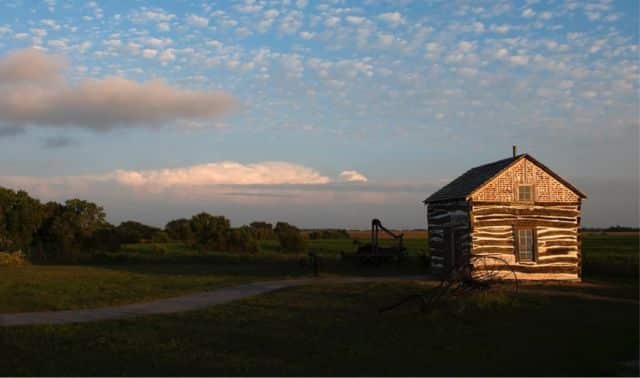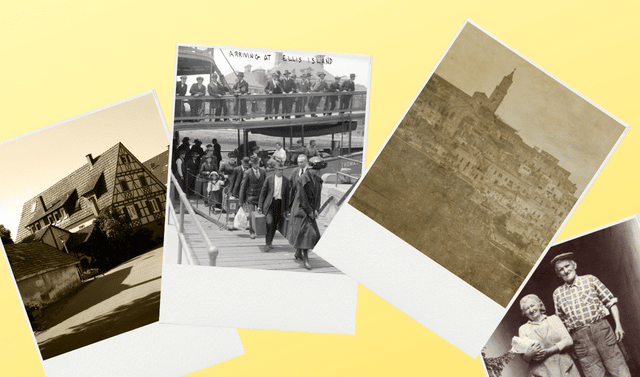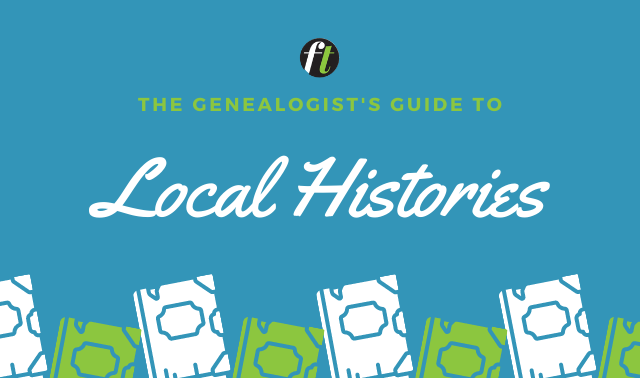Every region prizes its local foods: crisp Washington apples, grain-fed Iowa beef, fresh Maine lobster, sweet Vermont maple syrup. Homegrown favorites like these are proudly offered at roadside stands and on restaurant menus. Savvy visitors quickly learn what produce, dishes and delicacies to savor during their stays.
There’s such a thing as local fare for genealogists, too: research resources that burst with lively regional flavor. These sources offer mouthwatering details about your ancestors’ everyday lives—weather, fashion, food, health practices, local scandals and politics, neighborhood milieu, religious life and more. These details spice up your understanding of your ancestors and sweeten stories of the past.
Like specialty foods, local research resources can be tricky to find and use properly. You might not learn about them unless you visit in person. Sources may express a different flavor than you’re accustomed to, or spin a story that’s not altogether factual. But the authentic zing and zest that local sources bring to your research makes consuming them worth the effort. Work up your own appetite for local research fare with these six succulent resources.
Local histories
Like Wisconsin cheese, local history books come in many varieties, each uniquely crafted. At least 5,000 county histories have been published in the United States—chances are at least one covers your ancestors’ county. Many mark an anniversary, such as 50 or 100 or 200 years since the county’s formation or the nation’s birthday. County histories usually mention settlement and migration patterns, early families, illustrious individuals, historical industries, churches and schools, local government and more.
Other histories may be more specific, covering towns, townships, neighborhoods (in urban areas), schools, churches, synagogues and community organizations. How can you find local histories? Try these strategies:
• The Library of Congress (LOC) has cataloged more than 100,000 items in its Local History and Genealogy Reading Room. In the online catalog, select Basic Search, then Subject Browse as the search type. In the Search Text field, enter a specific location: city, county or state. Here’s a librarian’s tip: Use both the terms county and co to capture all results, for example, Cincinnati Hamilton County Co Ohio. Not all the items in this catalog are digitized on the LOC site; you may need to borrow them through interlibrary loan.
• FamilySearch catalogs its holdings by the location associated with the records, so it can be easier to find everything related to a specific place (though the holdings aren’t as complete as the LOC). From FamilySearch.org, click on Search, then Catalog, and enter the name of the city and/or county and state in the Place Name search (you don’t need the word county or co). If local histories have been microfilmed, you can rent them through a FamilySearch Center near you. The Family History Library (FHL) doesn’t lend out printed books.
• WorldCat helps you find local histories and locate copies of books you can borrow. (Soon WorldCat and FHL catalogs will be integrated online, making these steps easier.) You can use the city or county and state as keyword search terms, but subject terms are more reliable. Search WorldCat subject terms on the SearchFast web page. Type in the locale (for example, Millersburg) and subject options will pop up (a city by that name in different states, the Millersburg Glass Co., etc). Click the heading most relevant to your search, then click the Find in WorldCat link. Request titles you find through your home library’s interlibrary loan program.
• Digitized county histories are available through websites such as FamilySearch (click on Books), Google Books, Internet Archive, Accessible Archives, HathiTrust Digital Library and Ancestry. (Some of these sites require a subscription or are available only in libraries.) It may be easier to find books on these sites if you know a title to search for.
Finally, a bit of advice when whipping up genealogical recipes with local histories: Writers didn’t always confirm the facts, eliminate bias or tell the full story. Biographical sketches may have been submitted by families who paid for the privilege and supplied their version of the truth. Don’t expect to see poorer folks, women and minorities fully represented (some early Southern county histories for example, hardly acknowledge there was a local black population).
Neighborhood newspapers
To the genealogist, the local paper can be as juicy as summer melons from a produce stand, packed as they are with current events, gossip, opinions, advertisements, birth announcements, marriage and anniversary write-ups, obituaries, legal notices, community events, sports and weather. But just as roadside stands aren’t always easy to find, you have to search the right places for newspapers and hope the pickings are good.
Begin looking for historical newspapers at the free LOC website Chronicling America. Click on US Newspaper Directory, 1690-Present to search a database of known publications for a specific time period and location, as well those targeted to labor, language, religious and/or ethnic groups. Include neighboring cities and counties in your search if you come up short. After you’ve identified a promising hit, check holdings: Is the paper digitized at Chronicling America for the dates you need? If so, you can read it immediately.
If not, see if it’s been digitized at another website. Enter the newspaper title and city/state into your browser. Search the Google News Archive, Newspapers.com and newspaper sections of large data sites such as GenealogyBank, Ancestry.com and Archives.com. Look for state-level digital newspaper websites; find a partial index to papers at United States Online Historical Newspapers.
Most newspapers, though, are still available only offline. The newspaper directory at Chronicling America will tell you libraries holding the papers you need, or use WorldCat to sort by libraries near you. Original newspapers likely won’t circulate through interlibrary loan, but microfilmed copies may.
Once you’ve located a newspaper, savor its unique local flavors. Really digest the content. What issues and attitudes does the paper express? How much local news and gossip do you see, and does it appear in a consistent spot in each edition for easier perusal? Based on what you already know, where or when would your ancestors likely appear in the paper—a society column? In legal or political coverage? During a trial? An announcement of a birth, wedding, anniversary or death? Like local histories, coverage of the poor, women and ethnic minorities will be sparse in early years. Turn to ethnic or labor newspapers if appropriate for your family.
Historical maps
Maps set out a veritable visual feast of information for hungry genealogists. Different kinds of maps, drawn at various points in time, offer us meaty main-course fare or savory side notes:
• Plat maps outline property boundaries, identify landowners or residents, and may indicate the locations and footprints of buildings. Addresses, lot dimensions, tract or parcel numbers, subdivision names and other identifiers can help you match what you’ve found in deed descriptions. You may find old plat maps in books in a county courthouse or archive, or recent ones at the town hall or county engineer’s office. Many are available in the Cities and Towns sections of American Memory Map Collections, such as a 1798 map of New Orleans or an 1891 map of Minneapolis. Some are online at sites such as the Kentucky Digital Library, Indiana University-Purdue University Indianapolis, and Historic Map Works (available by subscription and through many libraries).
• Insurance maps, meant for city planners and insurance companies, detail urban and suburban neighborhoods down to the outhouses and asbestos content. The most well-known of these are Sanborn Fire Insurance Maps, which mapped about 12,000 North American towns between 1867 and 1977. Find a listing of Sanborn maps and links to digitized ones at the Library of Congress. Search additional maps in ProQuest’s Digital Sanborn Maps collection at a library near you. Regional or statewide collections of Sanborn maps are also available at many libraries.
• Topographic maps can be crucial to understanding an ancestral neighborhood—but you may not realize it until you see the mountain ridges in which an isolated Appalachian town is nestled. If the landscape has changed significantly over time (especially water features like creek beds and swamps), topographic maps may have limited usefulness, as most are relatively recent. That said, it’s worth looking for them in the Conservation and Environment section of American Memory Maps, mentioned above. You can also order historical and modern topographic maps from the US Geological Survey office.
• Street and transportation maps show how our relatives got around. Depending on the time and place, they show railroad lines and depots; canal routes and river systems; streetcar routes or overland roads and byways. Look for old neighborhood and street maps at historical societies and archives, but for maps of larger areas, widen your search to state or national sources (like the Transportation and Communication section of American Memory Maps).
Remember that maps drawn before or after your ancestors’ time may still be useful to a point. Lot boundaries and local landmarks may not have changed; prior or subsequent owners’ names can help you track deeds. But think critically and analyze maps carefully before generalizing content from another time period to your ancestors’ time.
Directories
Local directories are like recipe books for a city—or at least very long ingredient lists. These annual commercial publications listed a city’s potential customer base by surname. Initially, this meant white men, who had the buying power. Eventually directories listed everyone, sometimes twice (at work and at home). Entries often included everything a salesman would want to know: names of adults in the home, addresses, phone numbers, occupations, employers and even descriptive terms such as “widow.”
Most major American cities had directories by the mid-1800s and rural areas by the early 1900s. Early directories for any given city may have been published sporadically (or may have been lost), and publication lapsed in many cities during the Civil War. Otherwise, you can expect annual directories in most places once publication began. Internationally, big cities also had earlier coverage: London’s directories date to the 1600s and Edinburgh’s to the 1700s.
Much like cookbooks, some city directories have special sections. Use “criss-cross” listings, organized by address rather than surname, to identify neighbors, get a sense of the ethnic and socioeconomic makeup of the area, and find nearby businesses, schools and churches. Social directories or “blue books,” more common in larger cities, can tell you about your upper-crust ancestors—or your working-class ancestors’ employers. Professional directories may list your doctor or lawyer relative, and reveal the cultural climate in which he practiced (was he one of two or 200 lawyers in town?). Community histories, maps, deaths, move-ins/move-outs and other sections of city directories may vary from year to year.
Locating directories is relatively easy. City Directories of the United States of America lists directories held by major libraries—it’s not a comprehensive list, but it’s pretty thorough. Public and university libraries and genealogical societies often have their city’s directories and may even have them posted on their websites. If not, you may be able to borrow them through interlibrary loan. Additionally, Ancestry.com has an enormous collection of digitized city directories. Find links to online directories at the Online Historical Directories website.
Weather data
Similar to Florida oranges, weather collections are harvested locally but can be enjoyed from afar. Want to know whether the sun shone on Grandma’s wedding day? You just need internet access or a library card. Free US historical weather data dating to the late 1800s is online, and newspapers and history books report major weather events.
The National Climatic Data Center has free online reports gathered from local weather bureaus back to the late 1800s, organized by state and region. More-localized data is available for recent years: You can search daily temperature, wind and precipitation by ZIP code or city back to 1973 at The Old Farmer’s Almanac. Storm and other unusual weather data to 1959 is on the NOAA website. For the distant past, the best you may find are the weather predictions (based on past data) reported in The Old Farmer’s Almanac, or The Farmer’s Almanac as it was known when it was first published in 1792.
Tornadoes, floods, hurricanes and other severe weather events were usually written up in local newspapers or history books, such as Great Ohio River Flood of 1937 by James E. Casto (Images of America). Isaac’s Storm by Erik Larson (Vintage) recounts the 1900 hurricane in Galveston, Texas. Even if the tornado that devastated the family farm wasn’t documented in specific detail, you may get a sense of the chaos by reading about similar events.
Photographs
Images can evoke your ancestors’ times as powerfully as a spicy jambalaya or tangy North Carolina barbeque. Historical photographs capture the look and feel of a place and time: the streets, buildings, industries, social and ethnic groups. You often can sense how comfortably (or uncomfortably) people lived, dressed and related to each other. Body language, expressions, fashions, gestures—so many of our most human quirks are captured only by photos.
To find the best local photographs, do what you’d do if you wanted the best jambalaya: go to the locals and ask around. Excellent collections may be buried in files or hanging on walls at the town historical society, public library or a nearby college. Ask a society volunteer or town historian who else may have photos, including longtime local residents.
When you go looking for pictures, be prepared to copy them on the spot. Keep handy—and know how to use—a handheld scanner, digital camera or your mobile device. A FlipPal mobile scanner is nice on-the-go for smaller images, especially since it can capture something still in an album or hanging on the wall. If you have an iPad or iPhone, it’s worth investing in ScannerPro, an app that makes your device function like a scanner. (Genius Scan is a similar app, available both in the iTunes and Google Play stores.)
If on-site photo research isn’t possible, look online for a local digital archive: Examples in Ohio range from a township site such as Bainbridge Memory to larger sites such as Toledo’s Attic or the Southeastern Ohio Digital Shoebox Project. Check holdings of historical societies, major public libraries, university libraries and other repositories. Also look to the enormous national photo collection at American Memory, which is keyword-searchable for the town or city you’re trying to find. Check for information about copyright and permission to reprint photos you find on these sites. Finally, also look for a pictorial history. Arcadia Publishers alone has published more than 8,500 local and regional titles.
These scrumptious-sounding resources, whether selected a la carte or heaped buffet-style into your files, are guaranteed to season your family history with fresh, unique details. The best part? You can stuff yourself—er, your files—to your heart’s content with absolutely no regrets the next day. That’s an offer you won’t get from the local gumbo guys.




